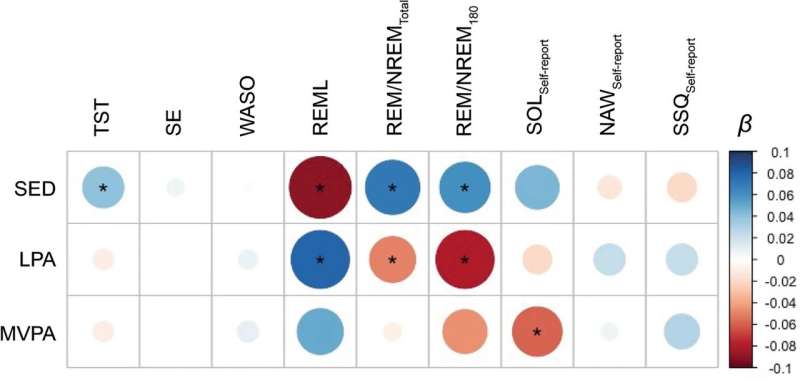This article has been reviewed according to Science X's editorial process and policies. Editors have highlighted the following attributes while ensuring the content's credibility:
fact-checked
peer-reviewed publication
trusted source
proofread
Move more, sleep better: Study finds physical activity lengthens REM latency

A new study by an interdisciplinary team of researchers at The University of Texas at Austin provides what may be the most reliable validation to date of the connection between physical activity, sleep quality and psychological health.
The study found that physical activity lengthened REM latency—that is, the time it takes to enter the REM stage. This may indicate that exercise helps consolidate deeper sleep stages before transitioning into REM sleep, which is when we tend to have vivid dreams and our brains seem to be as active as they are when we're awake.
Scientific studies backed by anecdotal evidence already testify to the fact that when we exercise regularly, we sleep better. And, when we sleep better, we feel better.
Although there is ample scientific evidence to support this, until now, the studies have been conducted in lab settings, with conclusions drawn from observing experiences after just one night's sleep. Such limited methodologies are problematic for any scientific study, regardless of how widely accepted the findings may be.
The study, published in Scientific Reports, investigated how daily physical activity patterns affect sleep stages and emotional well-being in a natural environment—at home, at work, and during daily activities—over several months.
The research team used advanced wearable technology to track sleep and activity levels in 82 young adults. A wrist-worn activity tracker recorded both movement and heart rate. From those signals, periods of deep (NREM) sleep and REM sleep, along with physical activity, could be determined. A separate smartphone app was used to collect self-reported well-being data.
The study emerged from a pilot study conducted as part of Whole Communities–Whole Health, a grand challenge research program that takes an interdisciplinary approach to how health care data are collected while also engaging communities and participants in the research process.
This more wide-reaching study successfully replicated many of the findings previously conducted in sleep labs: namely, that engaging in both low-intensity and moderate-to-vigorous physical activity was linked to deeper, more restorative sleep and that better sleep was, in turn, associated with more energy and less stress the following morning.
The key difference this time was the researchers' innovative use of wearable technology, which allowed for continuous monitoring of participants' behaviors, providing a comprehensive picture of daily activities and their impact on sleep and mood over multiple weeks, even months.
"You can learn a lot from lab studies, but obviously, there are limitations to studying the sleep patterns of individual participants in just one night," said Benjamin Baird, a research assistant professor of psychology and one of the authors of the study. "It's an unfamiliar, clinical-type setting, which can be stressful. And you can't really look over time, either. So, there are always questions about generalizability from that kind of design."
Baird said that researchers were able to address for the first time how these differences in sleep architecture are associated with people's perceived well-being. Sleep architecture refers to the structure of each 90 to 120-minute-long sleep cycle: the three stages of non-REM sleep (light, deep, and deepest NREM sleep) and REM sleep, which makes up the final 25% or so of each cycle.
"We've shown using a standard Fitbit that anyone could wear—not even an expensive scientific device—that it is actually sensitive to these sorts of sleep architecture measures, and in a way that's showing predictive results," said David M. Schnyer, a co-author and chair of the Department of Psychology.
"The world is your oyster now. You can use this device to study all manner of different sleep architecture data related to lifestyle—related to mood and mood disorders—in the field, not in a lab, that people might have thought was not possible previously."
More information: Kennedy Zapalac et al, The effects of physical activity on sleep architecture and mood in naturalistic environments, Scientific Reports (2024). DOI: 10.1038/s41598-024-56332-7





















